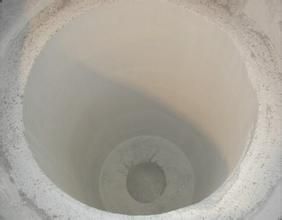Analyze the effect of coil cement products
Today, Luoyang Quantong Kiln Industry Co., Ltd. will show you what are the special advantages of using coil insulation cement?
1. After drying, the coil insulating mastic layer with a thickness of 8-15mm has a good insulating function, which can completely replace mica and glass wool cloth and act as an insulating protection layer between the coil and the furnace lining; the thermal conductivity of the mastic material is high. Concerned that a relatively thick layer of cement will affect the 3-layer junction of the hot-face lining;
2. The cement layer is located between the coil and the insulation layer. Under normal circumstances, the ambient temperature is very low (<300 degrees="" celsius.="" when="" the="" metal="" liquid="" approaches="" its="" surface="" occasionally,="" a="" small="" amount="" of="" residual="" moisture="" will="" be="" released="" from="" the="" cement="" layer,="" which="" will="" reduce="" the="" insulation="" resistance="" and="" supply="" the="" system.="" early="">
3. Using the refractoriness of the cement itself higher than 1800 degrees Celsius, when there is occasional leakage of metal liquid to its surface, the cement can provide a protective barrier to the coil, and when an alarm occurs, the cement layer can provide a certain time for accident handling;
4. For the furnace with bottom top-out type, the cement is made into a tapered shape to avoid the friction between the furnace lining and the coil, and at the same time, the coil is fixed by its strength, which avoids the use, construction and dismantling of the coil. The deformation during the furnace process prolongs the service life of the coil.
5. The coil and the cement layer are used as the permanent fire lining of the furnace. Although the one-time cost is high and the construction period is long, its service life can be the same as that of the coil, and local repairs can also be carried out, thus reducing the cost of building the furnace as a whole.
Before dry knotting the furnace lining, first lay a layer of asbestos board and a layer of glass fiber cloth in the insulation layer of the furnace coil. When laying, in addition to manually compacting the layers of materials, spring coils should be used to tighten up and down, and the quartz sand should be tamped. When the furnace lining is finished, move the spring coils one by one from top to bottom until the lining is knotted.

Previous: What are the differences between ramming material and castable material?
下一条: What are the precautions for the use of impermeable breathable bricks?
Related Industry Knowledge
- Features and Benefits of Coil Clay
- What are the advantages of a good furnace lining
- Misunderstandings in the use of ramming materials in intermediate frequency furnaces
- Phenomenon analysis of failure of argon blowing of ladle permeable bricks and how to improve the rate of argon blowing
- Where is the consumption reduction and energy saving of breathable bricks reflected?
- How to improve the service life of intermediate frequency furnace lining
- Reasons for damage to intermediate frequency furnace lining and how to solve them
- The performance and advantages of breathable brick
- Analysis of Structural Characteristics of Dispersive Breathable Bricks
- The intermediate frequency furnace charge knotting process needs to pay attention to details sharing
- What are the differences between ramming material and castable material?
- What are the requirements for the production materials of breathable bricks?
- Analyze the energy consumption and energy saving performance of breathable bricks
- What are the production process and control points of breathable bricks
- What are the effects of the lining material on the foundry electric furnace
- How to choose acid furnace lining correctly
- Will the ramming material be chemically attacked?
- Ramming material manufacturers teach you how to improve crack resistance
- How to use electric furnace lining to repair electric furnace
- What are the advantages of using converter breathable bricks?


